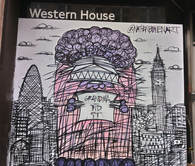|
The first in a series of occasional Grand Day Out blogs in which we share some of the activity-filled days, mornings or afternoons we enjoy when out and about for our own amusement.  A Grand Morning Out in London, W1 Start at the Oxford Circus tube station, Argyle Street exit and turn left. Almost immediately pause to see a piece of street art by Nathan Bowen who catapulted to fame following an appearance on The Apprentice in 2012. “Grandma Did It” was created in October 2016 to coincide with an event of the same name to raise money for dementia charities – a subject close to Bowen's heart as his own Grandma has dementia. www.londoncalling.com/.../nathan-bowen-street-artist Wander through the Liberty department store which was founded in 1875 and played a major role in popularising household items and fashions designed in the art nouveau and the arts and crafts movement styles. The mock -Tudor wing fronting onto Great Marlborough Street wing was built in 1924 and is a delight to stroll through - particularly atmospheric in the run up to Christmas. Liberty London, Regent St & Great Marlborough St, W1B 5AH http://www.telegraph.co.uk/fashion/brands/liberty-140th-anniversary/liberty-140-year-history/
 Time for coffee. Try Cafe Pomodoro in Kingly Street for old school cappuccino at £2.10 per cup. For additional fortification join the Crossrail construction workers tucking into full English breakfasts. Cafe Pomodoro, 2 Kingly St, W1B 5PB Cross Regent Street and head to Saville Row. As well as ogling the bespoke designer menswear there are many upmarket art galleries in this area, all of which provide the perfect opportunity for seeing a huge range of small art exhibitions free of charge.
Pace Gallery is another leading contemporary art gallery. It has 9 branches world wide including ones in Beijing, Seoul and New York. It represents some of the most significant artists of the 20th and 21st century including David Hockney, Barbara Hepworth and Picasso. The current London exhibition Impulse focuses on the work of five American abstract painters in the 1960s and 70s. Until 22nd December 2017. Until 22nd December 2017 Pace Gallery, 6 Burlington Gardens, W1S 3ET http://www.pacegallery.com/ A stroll through the elegant Burlington Arcade shopping arcade built in 1819 brings you onto Piccadilly and a gem of an exhibition.  Above the very smart premises of the “by royal appointment”, antique jewellery shop Bentley & Skinner is a banner announcing an exhibition called Faberge and the Russian Revolution. It feels rather surreal asking the uniformed commissionaire who opens the door if you are going the right way for the Russian Revolution but you are! Down in the basement, to the strains of the Russian national anthem, you discover that the father of the founder of this upmarket jewellers was a Russian revolutionary and friend of Lenin, who was forced to flee his country by the Tsar's secret police. The Russian revolution of 1917 brought about the end of the Tsar and the business of his favourite jeweller, Faberge. Rather ironically, given his father's revolutionary views John Sheldon who founded Bentley & Skinner began to collect and sell Faberge jewellery. The exhibition showcases his Faberge collection and also highlights the difference between the worlds of the revolutionaries and the Tsar. Until 30th November 2017. Bentley and Skinner, 55 Piccadilly, W1J 9EQ https://www.russianartandculture.com/faberge-and-the-russian-revolution-bentley-skinner-7-11-november/  Round off a Grand Morning Out with lunch at the Japan Centre in Panton Street. It has a great range of Japanese groceries, fresh fish and seafood as well as books and Japanese ceramics. There is also a large seating area where you can eat freshly prepared noodle dishes or pre-packed sushi. A good selection of sushi costs about £18 for two. Japan Centre, 35B Panton St, SW1 Y4DP https://www.japancentre.com/
3 Comments
Our guide, Jo has written a fascinating article on Holborn's Red Lion Square for London Heritage Hotspots.
Click here to read her article. Red Lion Square also features in Jo's Residents, Rascals and Riots walk. See Bloomsbury & Holborn in our Guided Walks section.  Last week saw another of those wonderful traditions of the City of London that make it such a unique place. Cart marking is organised by the Worshipful Company of Carmen, one of the City's ancient, but still very much active and alive livery companies, about which I have written before. This is the 77th Livery company in order of precedence (there are currently 110 livery companies) and they have a long history going back to 1517. The City has granted licences to carts to ply for trade for hundreds of years and this ceremony reflects that. Vehicles parade through Guildhall yard and are ceremonially marked with a red hot iron with the relevant letter for the year. This year is Y. I must confess that when I read about this I couldn't quite get my head around how the marking would be done without wrecking the paintwork! But it is fiendishly simple. There is a wooden plate attached to each vehicle and the branding is done on that. That never occurred to me which just goes to show how practical I am! It is usually done by the Lord Mayor, but in his absence this year the Lady Mayoress and one of the Sheriffs officiated. Now if you are wielding a red hot iron you need to ensure that you aren't burnt, so step forward another of the City's Livery Companies: the Worshipful Company of Glovers. They, of course, provide the heat proof gloves that are so essential. There was a wonderful parade of vehicles, from horse drawn carriages to modern street cleaning equipment. There was even a London bus driven by the head of British rail. And there were trumpeters to start and finish the event as you can see. Once all the vehicles have been marked, they parade once more through the yard. There was a bit of traffic jam as they left! As I was walking to the ceremony I overheard a conversation between two chaps walking along. One had obviously asked why there was some traffic disruption and the other said "oh it's one of those ceremonies..." Well yes it was and long may they continue! As you can see from the attached pictures the size of the vehicles to be marked ranged from a hand drawn funeral cart to something rather bigger.. How wonderful to live in a city where these things still happen..... Can you work out what the picture above is? I suspect not, even allowing for my not very good photography skills. It is tempting to blame the camera but that would not be fair. It actually shows the polished canopy at a new park just beside the Regent's Canal. Spring appearing to have sprung, or at least to be on the way, we took advantage of the warm weather on Sunday last to take a walk along part of the Regent's Canal. At King's Cross we visited Gasholder Park. Opened last November, it is a unique space. That word is often overused but I think it is appropriate here. This is part of the really amazing regeneration that continues apace around King's Cross. What a complete transformation from the really rather dingy, down at heel and often downright uncomfortable area it was during my childhood, to a vibrant and exciting new area. It even has a new post code, that is how impressive it is. (N1C in case you were wondering). The new development, in addition to the smart new office buildings and new homes and streets, includes 26 acres of public space, and Gasholder Park is surely one of the most interesting. The cast iron gasholders were a landmark and are now returning from a holiday in Yorkshire (I kid you not, that is where they were taken for restoration) to new lives and to being landmarks once again. But what different landmarks! New apartments are being built inside the frames of the others.
The pictures below show some of the incredible iron work and the park itself, but they don't do it justice, so, if you can, take advantage of the next sunny day and walk up and see it yourself. Gasholder park We rounded off our walk by having Sunday lunch in a pub garden, We had to keep our coats on but not bad for March I think, Sunshine, food and gasholders. Not a bad Sunday overall......
 The second concert was at the Foundling Museum and was entitled Happy Birthday Mr Handel. It was to celebrate the 331st Birthday of the composer who was a benefactor of the Foundling hospital that once stood on the site. If you have not heard of the Foundling Museum, you are missing a treat. The story of the first secular children's charity in this country, the first public picture gallery and the beginnings of charity and art and music coming together to raise money is a fascinating one. Thomas Coram was horrified to see the numbers of abandoned children in London in the 1700s and determined to do something for them. It took him 17 years but he did it and the Foundling Hospital looked after 27000 children until it closed its doors in the 1950s, although its work for children is continued today by its successor charity Coram. The museum chronicles the story of the Hospital and of the work of Thomas Coram and the artists and musicians who supported it. It is a fascinating story and a wonderful, child friendly museum. Do Go! Poems for Valentine’s Day with some link (however tenuous) to the City of London by a few of the City's Literati The Rising Sun, John Donne: Busy old fool unruly Sun, Why dost thou thus, Through windows and through curtains call on us? Must to thy motions lovers’ seasons run? Saucy pedantic wretch, go chide Late school boys and sour prentices. Go tell court huntsmen that the King will ride. Call country ants to harvest offices; Love, all alike, no seasons knows nor clime, Nor hours, days, months which are the rags of time. Thy beams so reverend, and strong Why shoulds’t thou think I could eclipse and cloud them with a wink Btu that I would not lose her sight so long. If her eyes have not blinded thine, Look and tomorrow late tell me, Whether both the Indias of spice and mine Be where thou left’st them, or lie here with me. Ask for those kings whom thou saw’s t yesterday And thou shalt hear, “All here in one bed lay” She is all states and all princes I; Nothing else is; Princes do but play us; compared to this, All honours mimic; all wealth alchemy. Thou, Sun are half as happy as we, In that the world’s contracted thus; Thine age asks ease, and since thy duties be To warm the world that’s done in warming us. Shine here to us, and thou art everywhere; This bed thy centre is; these walls thy sphere .John Donne, 1572 – 1631 Born in Bread Street, Dean of St Paul’s Cathedral Parliament of Foules, Geoffrey Chaucer: For this was on Saint Valentine’s day, When every fowl comes there his mate to take, Geoffrey Chaucer, 1343-1400 Born and lived for some of his life in London Sonnet 29, William Shakespeare: When in disgrace with fortune and men’s eyes I all alone beweep my outcast state And trouble deaf heaven with my bootless cries And look upon myself and curse my fate Wishing me like to one more rich in hope Featured like him, lie him with friends possessed Desiring this man’s art and that man’s scope With what I most enjoy contented least; Yet in these thoughts, myself almost despising Haply I think on thee, and then my state, Like to the lark at break of day arising From sullen earth, sings hymns at heaven’s gate; For thy sweet love remember’d such weal brings Tat then I scorn to change my state with kings. Ophelia in Hamlet, William Shakespeare: To-morrow is Saint Valentine's day, All in the morning betime, And I a maid at your window, To be your Valentine. Then up he rose, and donn'd his clothes, And dupp'd the chamber-door; Let in the maid, that out a maid Never departed more William Shakespeare 1564-1616 Lived and worked in London Diary of Samuel Pepys: 14 th February 1662 This morning in comes W. Bowyer, who was my wife's Valentine, she having, at which I made good sport to myself, held her hands all the morning, that she might not see the paynters that were at work in gilding my chimney-piece and pictures in my diningroom. 14th Feb 1667 This morning come up to my wife's bedside, I being up dressing myself, little Will Mercer to be her Valentine; and brought her name writ upon blue paper in gold letters, done by himself, very pretty; and we were both well pleased with it. But I am also this year my wife's Valentine, and it will cost me £5; but that I must have laid out if we had not been Valentines. So to bed. 1668 14th (Valentine's day). Up, being called up by Mercer, who come to be my Valentine, and so I rose and my wife, and were merry a little, I staying to talk, and did give her a guinny in gold for her Valentine's gift. There comes also my cozen Roger Pepys betimes, and comes to my wife, for her to be his Valentine, whose Valentine I was also, by agreement to be so to her every year; and this year I find it is likely to cost £4 or £5 in a ring for her, which she desires Samuel Pepys 1633 1703 Diarist, born and lived and worked in London  It occurs to me that all our blogs so far have been exclusively on the City. That's because that is mostly where I (Jo) do most of my wandering and walking. However, last week I was in Clerkenwell for one of Karen's excellent tours of St John's Gate. Highly recommended by the way (see the tour section). I was early so I wandered off to revisit the frieze that graces the front of the reconstructed Booth's Gin Distillery in Britton Street, which represent the stages of gin making. The frieze was originally on the front of the Distillery's administrative building in nearby Turnmill Street but when that was demolished the frontage was re-erected in Britton Street. The sculptures are by Frederick William Pomeroy, 1856-1924. His is a name that is not immediately well known although in my humble opinion it should be. One of the images is shown here and the others are on our Facebook page. So what is the link to justice? Readers of John Mortimer's hilarious Rumpole stories may remember that when Rumpole needed a drink he usually repaired to Pomeroy's wine bar. And those of you familiar with the Central Criminal Court in Old Bailey will certainly know the impressive figure of Justice that stands on the roof of the building sixty metres above street level. She too is by Pomeroy, standing some 3.7 metres high, made of bronze covered with gold leaf. And unlike many representations of Lady Justice she doesn't wear a blindfold.  And the Christmas trees? Well judge for yourselves. One of the saddest sights to be seen after Christmas I think. And not just after Christmas either, I saw a discarded tree in Hatton Garden on Christmas Eve!!!  29th December was the 75th anniversary of the bombing raid on the City that created the fire storm known as the second great fire of London. I joined many others in the City on the 29th to remember that day. Vintage fire engines were outside St Paul's Cathedral and at Dowgate Fire Station and could be seen and heard driving through the streets, with their crews dressed in the uniforms of the period. There were second world war soldiers and airmen, along with newspaper sellers and general public all equipped with their gas masks. Massey Shaw, the fireboat, was on the Thames pumping water as it had done 75 years ago. An air raid siren sounded (rather more quietly than it would have done in 1940) and finally there was a short service of commemoration for the fire fighters who lost their lives, by the Fire Fighters Memorial close to St Paul's Cathedral. The Fire Fighters Memorial is well sited in the shadow of this iconic building. In 1940, the Prime Minister Winston Churchill said that St Paul's must be saved at all costs, and it was. It is a favourite story of mine to tell visitors about the incendiary device that lodged in the dome and which, had it fallen inwards, could have spelt the end of the Cathedral. However it fell outwards and was extinguished. Wren's great cathedral rose from the embers of one great fire and survived this second one and it is still one of the most wonderful buildings anywhere in my view. I never get tired of it. Churchill described the firefighters as heroes with grimy faces and how true that still is today. It was wonderful to see a modern appliance and its crew join the procession and the service on the 29th. My Father, who is now in his nineties, remembers the 29th December 1940 because as an air raid warden in the Docks, he could see the glow in the sky as the City burned. I was glad to be part of the events to remember what he and all his contemporaries went through. For a great description of the 29th December go to A London Inheritance  The 2nd December was the date of the annual Boar's Head Ceremony in the City. It is one of those wonderful ancient traditions that are maintained in the City of London, which probably look completely bonkers to onlookers but which reflect the history and customs of the City. It is what makes the City so utterly wonderful in my book. The Worshipful Company of Butchers is one of the City's ancient livery companies, which have evolved from the medieval trade guilds. The Butchers are one of the oldest ones, having been around since at the very least the 12th century. In 1343 they got into a spot of bother when there were complaints about the waste from their trade and they were granted land to dispose of the er, detritus. This was conveniently situated so that said detritus could be thrown into the river Fleet, no longer current practice I am glad to report! The annual rent payable to the City? You've guessed it: a boar's head to be delivered to the Lord Mayor. And hence every year, to the accompaniment of beating drums the officers of the company process through the streets of the city to the Mansion House to pay the rent. Nowadays the head is not, alas, a real one. Our old friend Health and Safety now dictates that it must be a pretend one. It just makes it even more wonderful in my view. Where else would you have a procession of upright citizens marching in their finery, accompanied by military drummers, carrying a pretend boar's head? This year we marched along at the back and I have to say it felt GOOD! There's a lot to be said for tradition. People waved to us and took pictures and it was just great to be part of something that has been going on for centuries. When we arrived at Mansion House the Lord Mayor was there to receive the rent. Of course he doesn't really want the pretend head, so with echoes of Blue Peter (for those of you of a vintage to remember this) inside is a real one that was made earlier. The Lord Mayor dons his pinnie and carves it up. (I wonder if he gets training for this?) You can see pictures of him on the Butchers' website. www.butchershall.com It is really good to see that the Master of the Company is, in fact, a woman. This is just one of the lovely traditions of the City that are kept alive and vibrant and I intend to report on more throughout the year.  The City of London is very fortunate in so many ways, but today I am thinking particularly of its having not one but two guardian giants. Gog and Magog made their most recent outing at this year's Lord Mayor's show, leading the way as they always do. But how come the City has these giants and what on earth is the story behind them? As with all myths, it doesn't make too much sense if you try to analyse it, so I recommend that you don't think about it too hard! The Roman emperor Diocletian had 33 wicked daughters, whom he attempted to marry off to 33 husbands. The daughters weren't keen on this idea and under the leadership of Alba, one of them, plotted to murder their sleeping husbands. Not all together surprisingly, Diocletian decided at this point to cut off the daughters and they were cast adrift in a boat. Evenutally they washed up on the shores of a land that came to be called Albion, after Alba. Here they settled down with the local demons (clearly men much more to their taste) and raised a race of wicked giants. (You will just have to bear with me on this...) Cut to the arrival of Brutus, grandson of Aeneas, who has fled from Troy (yes I know the dates don't match) and arrives with his champion a huge man called Corineus. Corineus fought with the leader of the giants whose name was Gogmagog. Still with me? Gogmagog was thrown into the sea and as a reward Corineus got the western part of the country which was named after him and which we know today as Cornwall. And another version is that it was the Greek King Aegeas who had the daughters and not Diocletian and yet another that Gog and Magog were giants taken prisoner by Brutus and chained up at the gates of his capital New Troy, which became London. Originally the two giants seem to have been known as Gogmagog and Corineus but somewhere along the line Corineus disappeared and what we have now are Gog who carries a mace and Magog who carries a shield with a phoenix on it. Given that Corineus was the victor that seems a bit unfair to me but there you are. The statues have been in Guildhall for centuries. The current ones date from 1954, replacing 18th century ones destroyed in the blitz. They in their turn replaced 17th century ones, which being made of wicker and paste were apparently eaten by rodents. An earlier set were burnt in the Great Fire in 1666. Naughty children were told that they must behave lest they be eaten by the giants and there is a great short story by Charles Dickens which describes the statues coming to life and consuming prodigious quantities of wine. Giants have featured in coronation processions and in the Lord Mayor's procession since the 15th century. The statues in Guildhall are far too heavy to move and the Worshipful Company of Basketmakers gave the wicker ones that we see in the Lord Mayor's Show. They live for the rest of the year in a large cupboard just off the Great Hall and sometimes you can get a peek. By Jo |
AuthorsAs tour guides we have a wealth of fascinating facts, tips and experiences to share. Archives
November 2017
Categories |














 RSS Feed
RSS Feed